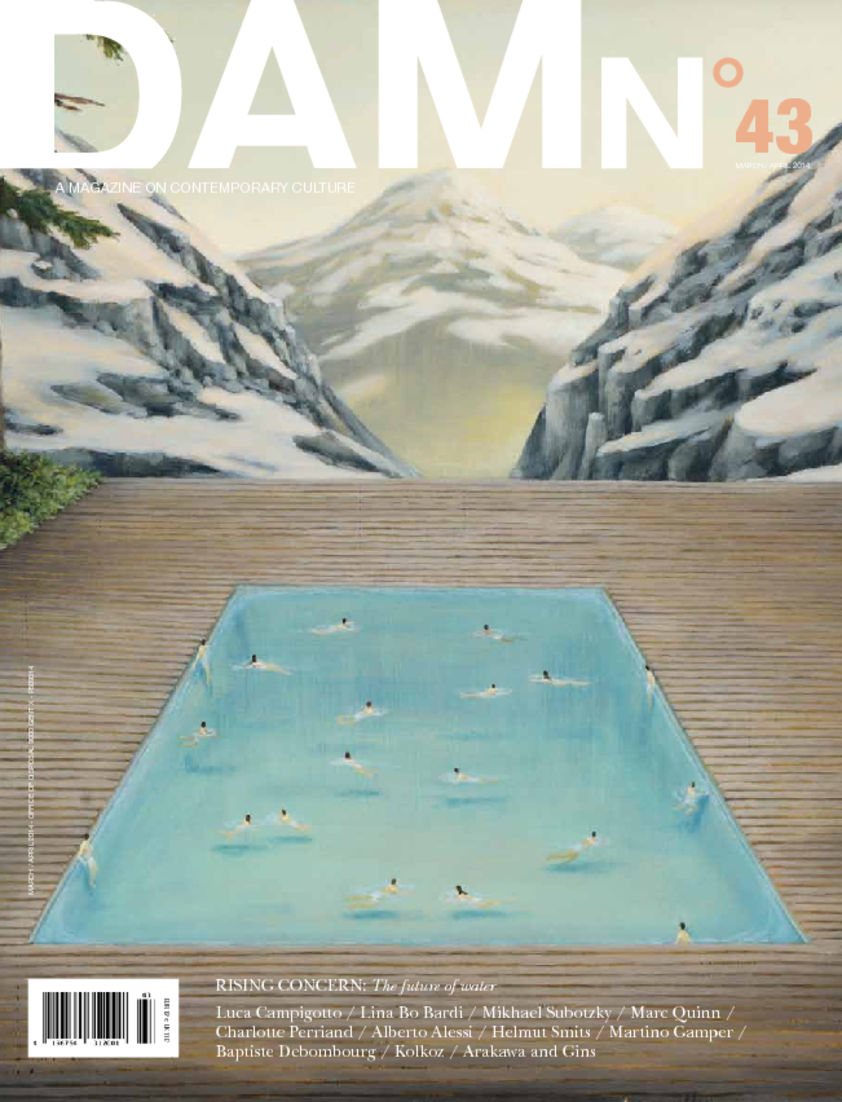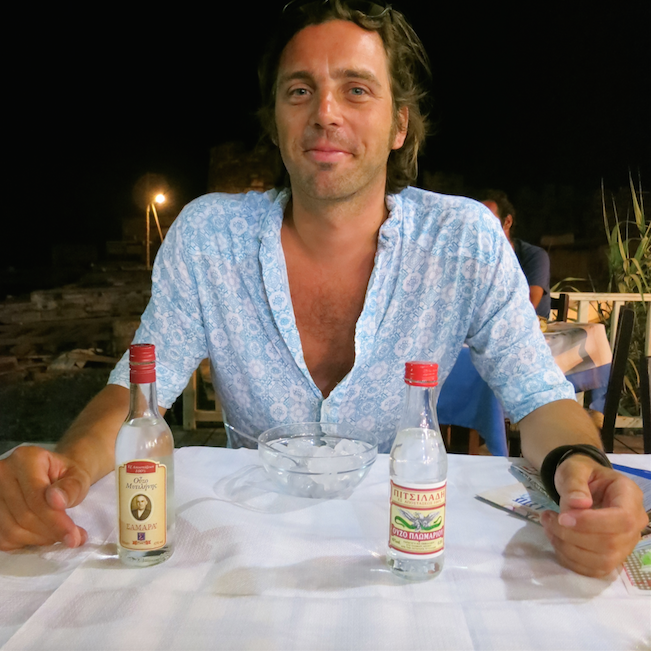Celebrating Scar Tissue
Baptiste Debombourg’s history of violence

TURBO, 2008/2009. Site specific installation at Patricia Dorfmann Gallery, Paris; wood; 320 x 730 x 300 cm (The series was started in Sarajevo in 2007, by now there are four realisations)
Although the artist doesn’t once mention it during this DAMN° interview, one could say that Baptiste Debombourg has a bit of a Humpty Dumpty complex going on… Prone to breaking objects to bits, simply in order to re-join the pieces, is not exactly standard practice. Alas, the technique is working well for him, that much is clear, and as such he is faring much better than all the king’s horses and all the king’s men. In fact, even though Debombourg exercises a certain form of destruction at the start of his artistic process, his favourite part is actually what happens afterwards.
An urban poet or someone in need of anger management therapy? Visual artist Baptiste Debombourg might be a bit of both. For his sculptural practice, Debombourg uses a wide range of (everyday) materials, which are often transformed through an act of violence. Broken glass, furniture that is deconstructed and then rearranged, or classical drawings made of staples, are just a few examples of how the artist sublimates anger into art – whether it is a bus stop or the Maison Martin Margiela boutiques in Paris and Miami.
Paris-based visual artist Baptiste Debombourg seems like a city poet who, like the 19th century flâneur, finds his inspiration in wandering around and observing daily life: from the carcass of a stolen motorcycle (which he evoked in the sculpture Rebel Without A Cause), to a run-over pigeon (to which he added coloured feathers that he then framed as a painting for the series Apollo), and a plastic bag covered in gold (with the ironic title Marx). With the leftovers of our consumer society, Debombourg makes art, both as a reaction to and a criticism of consumerism. “I observe everything around me. I am interested in human behaviour, so I use everything I find as raw material. These things are the evidence of life – cigarette butts, packaging, weapons, cheap furniture, ... All of them are things we desire, use, and then throwaway afterwards.” Take Social Philosophy, a photographic series depicting words and sentences made with cigarette butts. Y a pas que le physique (There’s nothing but the physical), Winner takes nothing or Mon ex-femme m’a piqué mon ex pognon (My ex-wife stole my ex-money). These are sentences the artists overheard from barflies in a local bar. “I was intrigued by these sentences”, he says. “It was often about a relationship with life, sometimes beautiful and poetic. Every time I heard an interesting one, I wrote it down, then formed it with cigarette butts and made a picture of the result.” Most of his works have more of a sculptural dimension, however. For those, Debombourg not only uses abandoned goods, but also new materials that go through a transformation process. For Articles Codes, he bought a cheap, standardised furniture set that he then destroyed with an axe and then reconstructed as if nothing had happened. The result is a series of furniture pieces that are reassembled but still clearly show their scars. The work expresses a kind of middle-class frustration. Violence seems to be omnipresent in the artist’s work. “Violence is just the first layer. In fact, I am much more concerned with what happens afterwards. I explore the question of psychology, identity, and society. My art rather deals with our weakness as human beings. For me, it is an energy and a way to survive.” His work does indeed have an energy, almost like a force of nature. Witness the site-specific installation Turbo, evoking an explosion by way of wall fragments that are extracted from the wall and then pieced together, forming an eruption in the wall face.
“The majority of my work focuses on shattered materials and plays with the opposition between construction and deconstruction”, Debombourg explains. “Destruction, like construction, is a human expression and a paradox of life.” A favourite material the artist uses to express that tension is glass. Flow consists of a cascade of broken windscreens and occupies an entire gallery space. The installation is reminiscent of a massive car crash, creating a fascinating effect. Somehow comparable is the work entitled Crystal Palace, consisting of a glass bus stop that looks trashed, but is actually meticulously built up of different layers of treated glass. Despite evoking riots in the French suburbs, the work also has an appealing beauty. “If you look at it for a while, it almost becomes like a jewel”, the artist conveys. Hence, after having made a site-specific installation of Turbo inside Maison Martin Margiela’s Paris boutique, Debombourg was invited to make a new installation, this time in the fashion designer’s Miami showroom. The artist was asked to come up with a new work to launch the new Swarovski jewellery collection, Crystalactite. Debombourg has done commissions before. “A lot of my works happen as a result of an invitation or a collaboration”, he claims. “For me, it’s exciting to create art outside of the white cube.” For his installation Stalker, in Miami, he was inspired by Swarovski’s new cut of crystal that uses an innovative fusion technique which blends the crystal with a matte white resin so it appears to emerge spontaneously from its natural, stony origin. Hence, the artist made cascading layers of shattered laminated-glass that covered parts of the clothes racks and displays, suggesting stalactites. “The main idea was to work with glass, in keeping with their jewellery collection, in order to express this idea of fusion through a new vision of the space. So I started as I always do, with the context, by observing the movement of the clients, the space, etc. My way of working on the project was to include the shop – the clothes and the furniture – and to create a hybrid between sculpture and display. It took five people two weeks and a lot of work, just to explain everything and find the right material!” And what of the reactions? “It was a big success”, he effuses. “Renzo Rosso, the president of the holding, wants to keep one part of the installation!” ‹
 STALKER, an installation by Baptiste Debombourg for ‘Crystalactite', the new jewellery collection at Atelier Swarovski by Maison Martin Margiela, Miami, 2013. Courtesy of Galerie Patricia Dorfmann, Paris
STALKER, an installation by Baptiste Debombourg for ‘Crystalactite', the new jewellery collection at Atelier Swarovski by Maison Martin Margiela, Miami, 2013. Courtesy of Galerie Patricia Dorfmann, Paris
 JUSTICE & PRUDENCE, 2012. Site specific installation at the Lieu Art Centre in Quebec, Canada; tv, wood, plastic bag, lithography; size variable; 10 x 8 x 1.6 m
JUSTICE & PRUDENCE, 2012. Site specific installation at the Lieu Art Centre in Quebec, Canada; tv, wood, plastic bag, lithography; size variable; 10 x 8 x 1.6 m
 Baptiste Debombourg.
Baptiste Debombourg.
 From the Social Philosophy series; cigarette butts.
From the Social Philosophy series; cigarette butts.
 This article appeared in DAMN°43. Order your personal copy.
This article appeared in DAMN°43. Order your personal copy.

